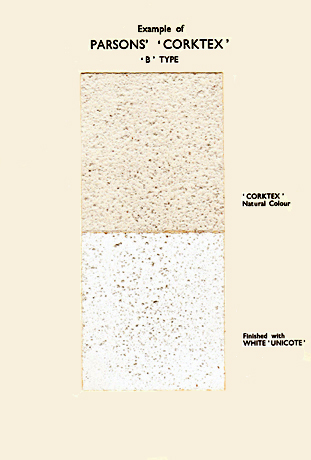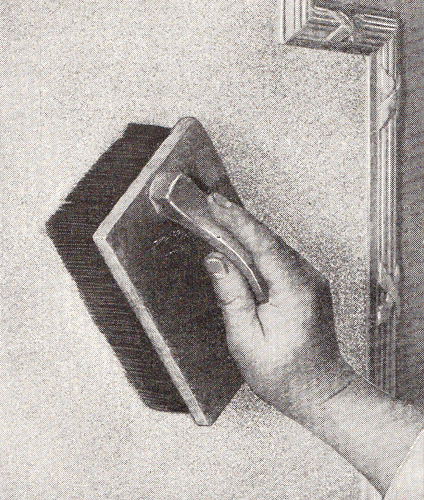
A previous post has already introduced the subject of a most useful work that was published in the 1930s – Parsons’ Decorative Finishes. Subsequently I have used it as a ‘prompt’ for posts dealing with Water Paint, Flat Finishes; Gloss Enamel Finishes and several other types of paint.

The book is divided into 17 sections and one of these (Section Fourteen) will be considered in this post which looks at the anti-condensation paint offered by Thomas Parsons’ at the time.
Anti-Condensation Paint
Cork and other textures
Granulated cork was often applied as an anti-condensation treatment for interior metal and plaster surfaces. This “corking” was carried out extensively in ships to minimise the effects of condensation from steel bulkheads and partitions, iron cold-water pipes, etc. A red lead primer was first applied and followed when dry with the adhesive coat, which may have been either a slow-drying enamel or a white lead stand oil-goldsize mixture. The granulated cork was thrown on to the tacky surface by hand, or blown on with a special spray gun, and the adhesive was then allowed to harden before the corked surface was finished with two or three coats of oil paint, the final coat often being a gloss enamel.

Cork, or other non-conductive material also formed the basis of proprietary anti-condensation paints, the application of these was carried out in a manner similar to imitation stone paints; that is, they would be applied very liberally in the stout consistency in which they were supplied, avoiding any attempt to brush the material out thinly. The efficacy of these anti-condensation preparations largely depended on the provision of a thick non-conductive coating which acted as a buffer between the warm moisture-laden air and the cold surface of metal or plaster; two coats were therefore usually recommended and each coat would be stippled to ensure uniformity of texture. As with stone paints, the spreading capacity was low and no more than 25 to 30 sq. yds. per gallon might be expected from the first coat if correctly applied, while the spreading rate of the second coat dropped to about 20 sq. yds. per gallon. Although the purpose of these paints was purely functional, the granular texture obtained was considered rather attractive and formed an ideal ground for broad decorative painting in flat oil paint, which may afterwards have been worked over with wax crayons.1

Parsons’ ‘Corktex’
As with the above, we are told that “‘Corktex’ presented a pleasing finish which might be coloured if desired.” There were two types of ‘Corktex’ as follows:-
‘Corktex’ ‘A’ Type (Powder form)
Supplied in powder form, which, when mixed with water, formed a paste to be applied with a trowel or brush, and when dry, should be painted with ‘Unicote’ Flat Oil Finish (white or colour), which was necessary in order to bind down the material and make it resistant to moisture.
‘Corktex’ ‘B’ Type (Ready for use)
Supplied in the form of paint ready for use, it was simpler in application and was therefore recommended for general use. Being of a thick consistency, a good coat should be laid on as when using an imitation stone paint. it was afterwards stippled to spread it evenly over the surface. This type of paint might also be sprayed on with a special type of spray gun, particulars of which were offered. It might be finished with ‘Unicote’ Flat Oil Finish or ‘Parlyte’ Water Paint in any colour.
Specification
For securing first-rate results
Walls and Ceilings
Upon Wood or Plaster –
Apply:
a) One coat of Parsons’ ‘Corktex’ (‘A’ or ‘B’ Type).
b) One coat of Parsons’ ‘Unicote’ (white or colour).
Ironwork (‘B’ Type recommended)
Clean free from rust, grease, etc., and apply:
a) One coat of Parsons’ Anti-Rust Priming Paint.
b) One coat of Parsons’ ‘Corktex’ ‘B’*
c) One coat of Parsons’ ‘Unicote’ (white or colour).
Notes
1 A.E. Hurst. Painting and Decorating Charles Griffin, London. 8th edn. 1963. p.251.
View Larger Map












No comments yet. Be the first!